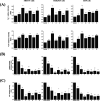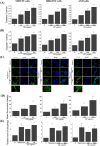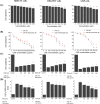Exploring the Cellular Impact of Size-Segregated Cigarette Aerosols: Insights into Indoor Particulate Matter Toxicity and Potential Therapeutic Interventions
- PMID: 38870402
- PMCID: PMC11256904
- DOI: 10.1021/acs.chemrestox.4c00114
Exploring the Cellular Impact of Size-Segregated Cigarette Aerosols: Insights into Indoor Particulate Matter Toxicity and Potential Therapeutic Interventions
Abstract
Exposure to anthropogenic aerosols has been associated with a variety of adverse health effects, increased morbidity, and premature death. Although cigarette smoke poses one of the most significant public health threats, the cellular toxicity of particulate matter contained in cigarette smoke has not been systematically interrogated in a size-segregated manner. In this study, we employed a refined particle size classification to collect cigarette aerosols, enabling a comprehensive assessment and comparison of the impacts exerted by cigarette aerosol extract (CAE) on SH-SY5Y, HEK293T, and A549 cells. Exposure to CAE reduced cell viability in a dose-dependent manner, with organic components having a greater impact and SH-SY5Y cells displaying lower tolerance compared to HEK293T and A549 cells. Moreover, CAE was found to cause increased oxidative stress, mitochondrial dysfunction, and increased levels of apoptosis, pyroptosis, and autophagy, leading to increased cell death. Furthermore, we found that rutin, a phytocompound with antioxidant potential, could reduce intracellular reactive oxygen species and protect against CAE-triggered cell death. These findings underscore the therapeutic potential of antioxidant drugs in mitigating the adverse effects of cigarette aerosol exposure for better public health outcomes.
Conflict of interest statement
The authors declare no competing financial interest.
Figures







Similar articles
-
Cellular and Acellular Assays for Measuring Oxidative Stress Induced by Ambient and Laboratory-Generated Aerosols.Res Rep Health Eff Inst. 2019 Mar;2019(197):1-57. Res Rep Health Eff Inst. 2019. PMID: 31872749 Free PMC article.
-
Understanding the Early Biological Effects of Isoprene-Derived Particulate Matter Enhanced by Anthropogenic Pollutants.Res Rep Health Eff Inst. 2019 Mar;2019(198):1-54. Res Rep Health Eff Inst. 2019. PMID: 31872748 Free PMC article.
-
E-Cigarette Aerosol Exposure Induces Reactive Oxygen Species, DNA Damage, and Cell Death in Vascular Endothelial Cells.Toxicol Sci. 2016 Dec;154(2):332-340. doi: 10.1093/toxsci/kfw166. Epub 2016 Sep 9. Toxicol Sci. 2016. PMID: 27613717
-
In vitro toxicity testing of cigarette smoke based on the air-liquid interface exposure: A review.Toxicol In Vitro. 2016 Oct;36:105-113. doi: 10.1016/j.tiv.2016.07.019. Epub 2016 Jul 26. Toxicol In Vitro. 2016. PMID: 27470133 Review.
-
Indoor aerosols: from personal exposure to risk assessment.Indoor Air. 2013 Dec;23(6):462-87. doi: 10.1111/ina.12044. Epub 2013 May 13. Indoor Air. 2013. PMID: 23574389 Review.
References
-
- Samoli E.; Peng R.; Ramsay T.; Pipikou M.; Touloumi G.; Dominici F.; Burnett R.; Cohen A.; Krewski D.; Samet J.; et al. Acute effects of ambient particulate matter on mortality in Europe and North America: results from the APHENA study. Environ. Health Perspect. 2008, 116 (11), 1480–1486. 10.1289/ehp.11345. - DOI - PMC - PubMed
MeSH terms
Substances
LinkOut - more resources
Full Text Sources

